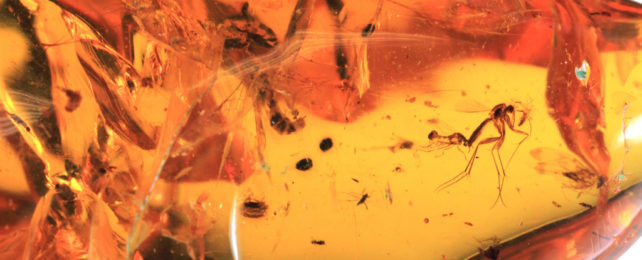Fossilized treasures entombed in golden, glassy amber capture countless stories of ancient forested landscapes through which the dinosaurs roamed. Sometimes these prized fossils are part of a very different story.
One such instance is in Myanmar. While embroiled in political turmoil, the country has also enchanted the field of paleontology with spectacular amber specimens that are sourced by unethical or illegal means.
According to a new study – described by scientists not involved in the work as "one of the most important papers in paleontology you'll read this year" – research on fossils encased in Myanmar amber is booming, a direct result of ongoing violent conflicts in parts of the country where amber is mined.
Amber sourced from Myanmar has in recent years yielded a wealth of dazzling specimens, preserved in exquisite detail. From feathered dinosaur tails to fossilized flowers and metallic insects, the burnt-orange blobs of hardened tree resin have trapped life that flourished some 99 million years ago, alongside the dinosaurs during the mid-Cretaceous.
But those finds come with a cost.
Since 2019, reports have emerged that the trade of lucrative amber, and the fossils it often contains, is fueling conflicts in Myanmar, representing an 'ethical minefield' for paleontologists wishing to study the specimens.
"We already knew that the situation was bad through anecdotes and journalistic investigations, but our study finally puts the situation into perspective and shows just how bad the situation really is," paleontologist Nussaïbah Raja of Friedrich Alexander University (FAU) of Erlangen–Nuremberg in Germany explains to ScienceAlert in an email.
"Our analysis shows the extent to which scientists have been exploiting the legal conundrum that Myanmar amber represents."
Since 2015, exporting fossil materials from Myanmar has been prohibited. But because the amber can be exported legally, fossils contained within it fall into a legal gray area.
"Where does the fossil end and the amber begin?" asks Raja in her email.
Yet research on Myanmar amber fossils is roaring, according to the new analysis. The researchers scrutinized nearly 1,000 scientific papers published over the past 30 years on Myanmar amber fossils and found that the explosion in papers since 2014 tracks closely with major political, legal, and economic events occurring at that time in the country.
Some paleontologists have questioned the study findings, arguing that the dramatic increase in research on Myanmar amber fossils simply reflects growing academic interest.
But the study authors argue that the soaring number of papers on fossils preserved in the golden gemstone is "explicitly linked" to the country's violent conflict and "seriously deficient" enforcement of national laws. And foreign paleontologists are among those who benefit.
"Myanmar amber represents the starkest case of how loopholes in the law continue to be exploited, resulting in unethical work and the exclusion of local researchers," fellow FAU paleontologist and co-lead author of the study Emma Dunne said on Twitter when sharing the team's new paper.
Most of the amber is mined in northern Myanmar, in the conflict-ridden Kachin state, where rival political factions have been warring for control of the area and profiteering off the amber trade.
The gemstones smuggled across the border into China are sold in markets, often to private collectors and paleontologists, which means local scientists in Myanmar have little opportunity to study the ancient remains, the analysis found.
"Until 2022, there have been no authors based in Myanmar who have contributed to a scientific paper that describes a fossil embedded in Myanmar amber," Raja explains.
Since 2014, China has published more papers on Myanmar amber fossils than any other country, followed by the United States. This, the researchers say, reflects the influx of Myanmar amber into Chinese markets from 2014 onwards.
"What we observed here is an extreme form of parachute science where instead of fieldwork, amber specimens are obtained through commercial routes and are apparently not regulated accordingly by national laws relating to fossils or gemstones," Raja, Dunne, and colleagues write.
Parachute science – where researchers from wealthy nations jet in to conduct research without involving local scientists – is a legacy of a dark colonial history that continues to be exploited today, and which ultimately warps our view of life on Earth.
Other recent studies analyzing the authorship of scientific papers have similarly exposed how pervasive parachute science is in coral reef research and geoscience. Unsurprisingly, paleontology is no exception.
"Documenting who is – or more precisely, which countries are – publishing on Myanmar amber allows us to clearly see that this same imbalance is extremely prevalent in this field of research," Dunne adds.
Despite calls from paleontological societies for scientific journals not to publish papers on fossils in Myanmar amber, and some journals adopting stricter policies in response, progress to curb unethical or illegal research practices in paleontology has, on the whole, been slow.
The latest analysis found that only 2 out of 222 papers published since 2020 describing fossils in Myanmar amber detailed in the supplementary methods how their specimen was legally and ethically acquired.
While seeing this kind of data might be a wake-up call to some researchers, it spells out a sobering reminder to other paleontologists who are reckoning with the field's colonial past and how to improve its ethical standards.
"Myanmar amber is beautiful. The fossils inside are stunning. I get the excitement and desire to study them," University of Edinburgh paleontologist Steve Brusatte tweeted upon reading the study. "But to me, while war still rages, no fossil is worth a single human life."
The study was published in Communications Biology. It was co-authored by Zin-Maung-Maung-Thein, a paleontologist at the University of Mandalay in Myanmar.
